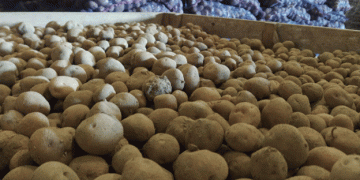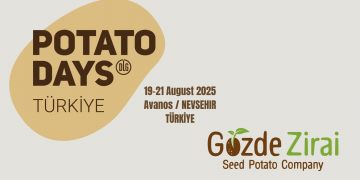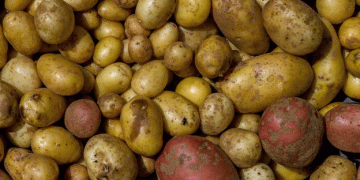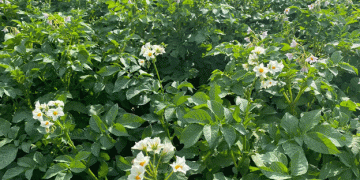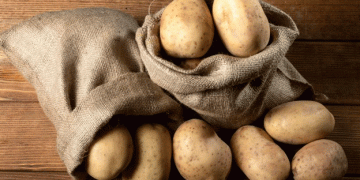Cover crops are crops which are not sown to be harvested but rather to be incorporated in the soil at some point in their growth. In potato farming, cover crops can be grown to:
* protect the soil from erosion;
* provide fresh organic matter that will improve soil tilth;
* prevent the leaching of nutrients;
* serve as sources of nitrogen (in the case of leguminous cover crops); and
* help in the management of certain pest problems (e.g.: weeds, nematodes).
Cover crops can be used in the following ways in potato production:
* As green manures established the year before planting potatoes. Several studies report an increase in yield and quality of potatoes with a preceding cover crop due to improved nutrient cycling and soil tilth. This seems especially true in warm climates where the turnover of nutrients is rapid, but has also been reported in cold climates. It is estimated that the effect of a preceding cover crop is equivalent to the application of 10 to 90 t/ha of manure, depending on whether the green manure was fertilized or not.
* As catch crops after potato harvest. A catch crop is a crop grown in the same year as the main crop but after the main crop. The main role of cover crops in this case is to protect the soil from erosion and to prevent leaching of nutrients unused by the potatoes. It can be tilled in the fall or kept as an overwintering cover crop that will be tilled in the spring.
* As a full-season crop in rotation with potatoes. The aim of this practice is usually to increase soil organic matter levels and involves turning in mature plants rather than green ones. It can also be part of a non-chemical weed or pest control strategy.
The types of plants to be used as cover crops can be classified in five main categories:
* Legumes;
* Cereals and grasses;
* Crucifers;
* Other families of plants;
* Mixtures of the above.
Let’s examine the advantages and disadvantages of these plants and see how they can be used profitably in potato production in Northeastern North America.
LEGUMES
The legume family comprises fodder crops like clovers, vetches and alfalfa, as well as pulse crops like soybeans, fababeans and lupine. Their ability to fix nitrogen from the air with the help of specific bacteria gives them a special value as source of “free” nitrogen on the farm. Unfortunately, legumes usually require for their optimal growth a higher soil pH than that needed to produce scab free potatoes.
The most commonly used legume species for cover cropping are red clover and hairy vetch. Small red clover is a favorite for cereal underseeding because of its low seed cost and the fact that it does not grow as tall as medium red clover, therefore not hindering mechanical harvesting. However, clovers can host verticillium wilt. According to a Dutch study, white clover undersown in cereals can have a negative effect on the following potato crop yield. Hairy vetch is a fast growing winter annual legume but does not survive winter in most of Canada which makes it useful as a cover crop.
Pulse legumes are mostly used as rotation crops but can also be used as cover crops. Soybean is a very good green manure before potatoes especially in warm climates. It is more tolerant of soil acidity than most legumes and is good against scab. A disadvantage of soybean grown as a crop is that it produces little residue and so does not contributes to the maintenance of soil organic matter levels. Lupine is a favorite in Eastern European countries as a cover crop preceding potatoes. Its effect on yields typically lasts for two years in the rotation. However, few lupine varieties are adapted to Northeastern North America. Beans have an inhibiting effect against nematodes and rhizoctonia and could be an interesting choice under our conditions.
Legumes before potatoes
Legumes can be planted as full season cover crops with a cereal nurse crop (e.g.: small red clover undersown in oats, barley or wheat) or as a catch crop in the year before potatoes. The advantage of the cereal nurse crop approach is that a harvestable crop can be secured. The legume develops fully after the cereal harvest. On light soils, it is plowed in the following spring and serves as a slow release source of nitrogen for the potato crop while protecting the soil all winter. In a German study, clover undersown in cereals gave higher potato yields the following year than either rape, sunflowers or legumes sown after cereal harvest. Because legumes develop rather slowly development, they may not provide a good cover if planted as catch crops after the cereal harvest.
After potatoes
As is the case for cereals, it is usually too late after potato harvest to plant a legume, unless it is an early harvest. Sowing a legume at the beginning of August does not leave much time for development and is risky in a dry year (packing of the seed bed is recommended). Hairy vetch and crimson clover develop faster than many other legumes and are recommended as catch crops after early potatoes. Unfortunately, their seeds are expensive and they will fix as little as one fifth the nitrogen of a spring sowing.
CEREALS AND GRASSES
a) Rye
In several countries, rye has been the most popular cover or rotation crop for potatoes, especially for light soils. Unlike legumes, it does not need a high pH and is very competitive with weeds. It is one of the best plants to prevent nitrate leaching in the fall. Rye is also very tolerant of low winter temperatures. Unfortunately, rye is difficult to kill in the spring and it can be a host for nematodes that attack potatoes. As a cash crop, rye has a limited market in Eastern Canada, although it can be used as animal feed. Rye is also very susceptible to ergot.
Before potatoes
Rye can be planted after another cereal crop. Since it is not winter killed, it needs to be destroyed the following spring by tillage or herbicides. Rye is sown at the same rate as other small grains (100-120 kg/ha). Rye may or may not have a positive effect on the subsequent potato yield.It was common practice early in this century in sandy potato soils of New Jersey and Long Island to have rye or a mixture of rye and vetch turned in before potatoes. Rye’s role was to maintain tilth in these soils, nitrogen being furnished by mineral fertilizers. Plowing was done early in the spring it was found that a small amount of rye turned under every year was better than a large amount less frequently.
After potatoes
Rye is also a good cover crop after a late potato harvest. Rye has an unmatched ability to grow in the low fall temperatures. It provides a protective soil cover for the winter that is cheaper than hay mulches. In northern regions, rye should ideally be sown in early to mid-September, while in more favourable regions it can be sown up to early October. If sown later, higher seeding rates should be used. An alternative to drilling rye after the potato harvest is to broadcast it before digging the potatoes. If rye is going to be harvested the following year, it is recommended to chop the straw after harvest and incorporate it well. Rye seeds left behind will germinate and make a nice cover crop. Another option is to frost-seed legumes in the rye in the spring.
b) Spring cereals
Spring cereals are more often used as rotation crops than as cover crops with potatoes. However, oats, barley or even wheat can be sown as inexpensive catch crops after potato harvest. In contrast to rye, they die in winter, which could be an advantage. If a spring cereal is used as rotation crop sown in spring and harvested in August, seeds that are left behind will often provide a nice cover crop. Barley is not the best choice as it was shown to increase scab levels in the following potato crop.
c) Grasses
Japanese millet, sorghum/sudan grass or ryegrass can be used as full season cover crops and can also be sources of forage. Most often, these crops are grown to maintain the soil humus content which is often rapidly destroyed in potato culture. The disadvantages of Japanese millet and sorghum/sudan grass are that you need to wait until all danger of frost is over to plant them. While waiting, erosion can take place. Annual soil coverage is therefore not very good with this option.
CRUCIFERS
Cruciferous cover crops are plants of the cabbage family like white mustard, oilseed radish and canola/rape. They are commonly used as cover crops in potato farming, especially in Eastern European countries. They can be planted soon after cereal harvesting (seeding rate: 10-15 kg/ha) or after early potato harvest. The crucifer is either unfertilized, or fertilized prior to planting with manure or even mineral fertilizers.
Crucifers offer several advantages. They grow quickly, resist cold fall temperatures, are excellent nitrogen accumulators, their seeds are cheap and they are winter-killed. They also suppress nematodes. Moreover, mustard has proven to have a suppressive effect against scab and rhizoctonia. One possible disadvantage is phytotoxicity in a cool spring.
Before potatoes
Cruciferous cover crops generally increase dry matter content of the following potato crop. In the Ukraine, rape or radish cover crops have been found superior to a peas-oats mixture before potatoes. In Poland, successful experiments have been done where part of the nitrogen normally applied to the following potato crop is applied to rape the fall before. The cover crop then contributes significantly to potato nutrition. In Germany, a system has been developed where the land is prepared for the next potato season after the cereal harvest, and the ridges formed and ready for planting. A cover crop of oilseed radish or mustard is planted along the ridges to provide a soil cover during the winter. In the following spring, the potatoes are planted with the frost-killed crucifers still covering the soil. Potato yields have improved with this system. In Russia, a cover crop of either radish, mustard or rape following the harvest of rye has had a positive effect on the following potato yield.
After potatoes
Crucifers can be planted after an early potato harvest. They effectively prevent nitrate leaching while controlling weeds and protecting the soil. Being winter killed, they should ideally be tilled into the soil the following spring. In dry conditions, such as on the Prairies, crucifer residues sometimes cause while decomposing phytotoxic effects on the following cereal crop . If crucifers are planted late (late August-early September), heavier seeding rates should be used. If the fall is unusually warm, mowing at flowering stage may be necessary to prevent mustard from going to seed.
OTHER COVER CROPS
Phacelia is another option but is more expensive to sow than the plants discussed previously. It grows like spring cereals but can be sown as a fall catch crop after cereal or early potato harvest. Sunflowers is a sturdy cover crop and is very good against weeds, but it requires heat and is therefore more appropriate in warm regions. Buckwheat is fast growing but can hardly be used as a catch crop because it is easily killed by frost. It is therefore more useful as a rotation crop or as a full-season cover crop. For example, for a good field cleaning, two or three successive sowings of buckwheat in the same season can be done. The risk of self-seeding is high with buckwheat.
MIXTURES
Considerable research work has been done (mostly in Europe) on mixtures of various cover crop species. Apart from reducing weed problems, mixtures are generally superior to single species cover crops on the following potato crop yields. For example:
* A rye/vetch mixture is superior to either rye alone or rape alone;
* A mustard/vetch/peas mixture is superior to mustard alone;
Some mixtures are also better or equal to others. For example:
* A rape/radish mixture is superior to an oats/peas mixture;
* A rye/vetch mixture is equal to a rye/rape mixture;
* Rye/Vetch or rape/vetch mixtures are an excellent choice with a light (10 t/ha) manure application.
A major study is being conducted at the University of Maine using a two-year rotation consisting of potatoes followed by a full season cover crop of oats-pea-vetch (50lbs-100lbs-30lbs/acre). This mixture provides up to 250 lbs. of nitrogen/ac for potatoes.
TO FERTILIZE COVER CROPS OR NOT?
Generally, fertilizing green manure crops is not recommended. However, better results have been obtained on the following potato crop when green manures were fertilized with manure or N fertilizer, or both. Doses do not need to be high (e.g. 10-20t/ha manure or 60kg N/ha). If they follow a potato crop, green manures should not be fertilized, so they act as catch crops and recycle all the nutrients.
INTERSEEDING COVER CROPS IN POTATOES
Systems of potato production with interseeding are being studied at Cornell University. The first results are not too promising. Reduced potato yields were observed with interseeded cereals and/or legumes. Moreover, an adequate weed control could not be achieved with the interseeds only, whether they were sown 3, 4, or 5 weeks after the planting potatoes. Herbicides that would not kill the interseeded plants had to be used to achieve an acceptable level of weed control. It therefore appears that interseeding as studied by Cornell researchers is not appropriate for potatoes.
COVER CROPPING SCENARIOS FOR A TWO-YEAR ROTATION
For most Northeastern North American potato farms, a two year rotation with one in potatoes is the standard. Longer rotations would be better, but economic considerations limit this possibility in most cases. An ideal three-year rotation for most farms would be potatoes/undersown spring cereal.
Table 1 presents various scenarios for a 2 year-rotation, with an estimation of their merits with respect to soil coverage, nitrogen management, weed management, organic matter level, and economic return. These scenarios show that there are several ways cover crops can be introduced in a simple production system. The best two-year rotation scenario depends on each farm situation. A farm with nematode problems will often respond to the use of cruciferous cover crops while one with a severe organic matter deficit on flat land might be better off with Japanese millet as a rotation crop.
The following two-year rotation incorporates many of the advantages of cover crops (scenario F in Table 1):
Year 1– Potatoes are harvested in early September- Fall rye is sown right after potato harvest
Year 2– Rye is turned in as early as possible in the spring- Spring cereal is sown with legume underseeding- Cereal harvested in August with straw shredded finely- Legume left to develop- Legume is incorporated in the spring before potato planting or in late fall if the land is not prone to erosion.
This scenario offers very good soil coverage. The only time the soil is bare is when potatoes and the spring cereal are just planted and at potato harvest. Weed control should also be good because of the rye and the underseeding in the cereal. Organic matter return is good as the young organic material provides soil tilth and the older material (straw) contributes to humus formation. Residual nitrogen retention is very good because of the rye, and a good quantity of fixed nitrogen can be added to the system with the legume developing after grain harvest. Finally, the economic return is one of the best since two crops are sold in the two years. If the soil humus level is high, or the farm has access to solid manure or compost, the straw could also be sold to provide additional revenue.
Whatever your situation is, experiment with cover crops on your farm and find which strategy will best benefit you and the environment.
Ecological Agriculture Projects, McGill University (Macdonald Campus)


